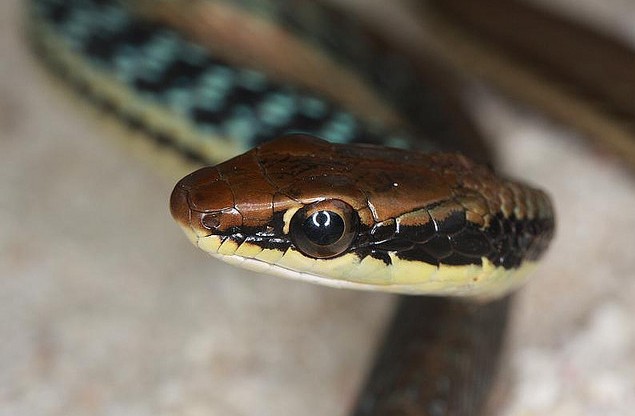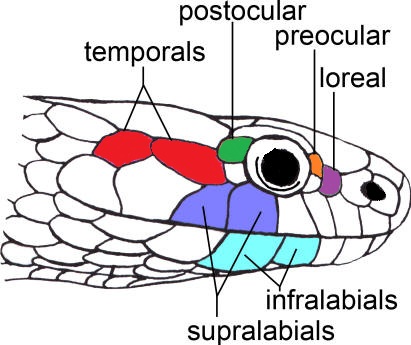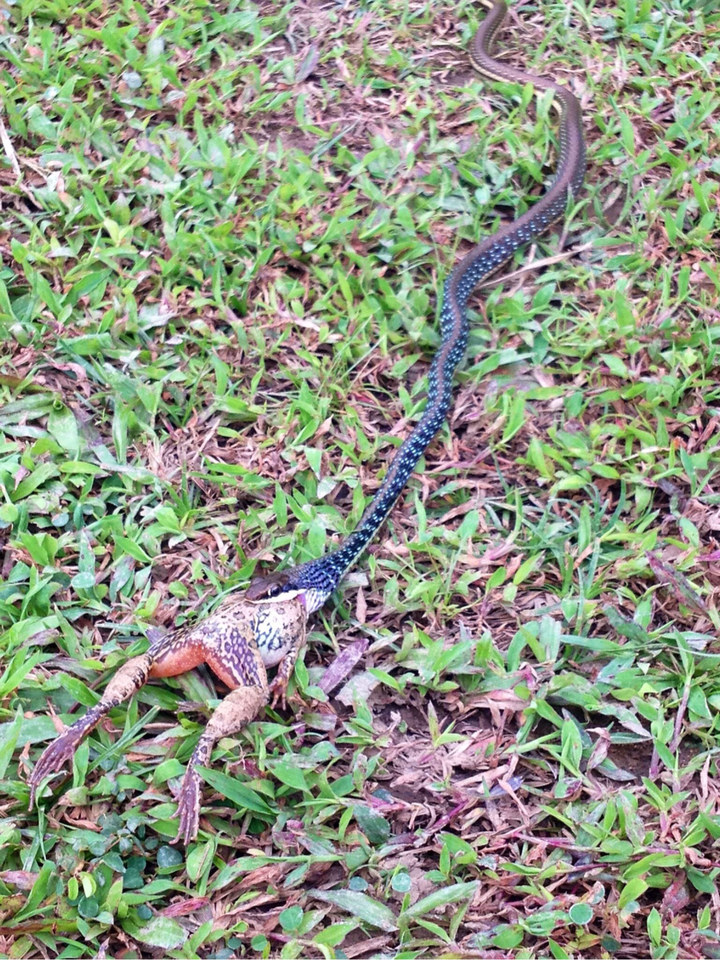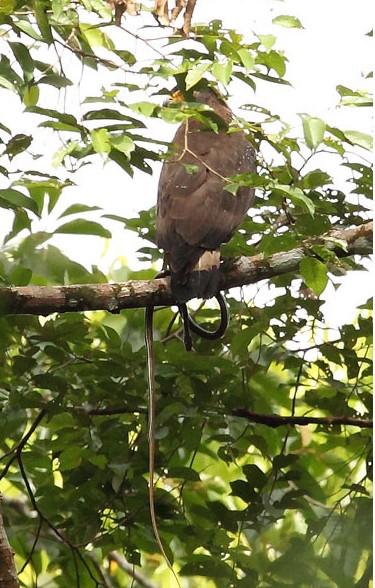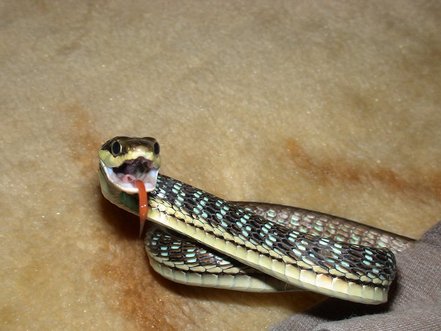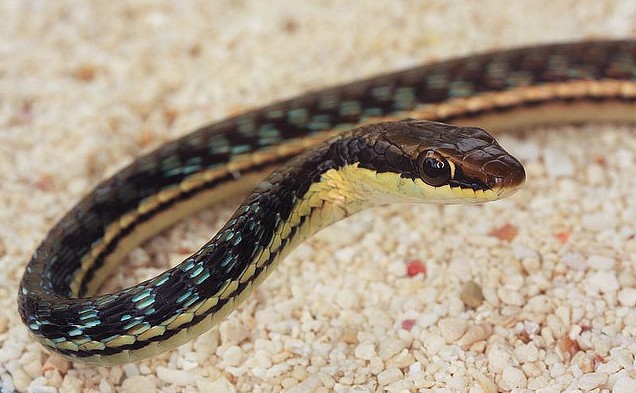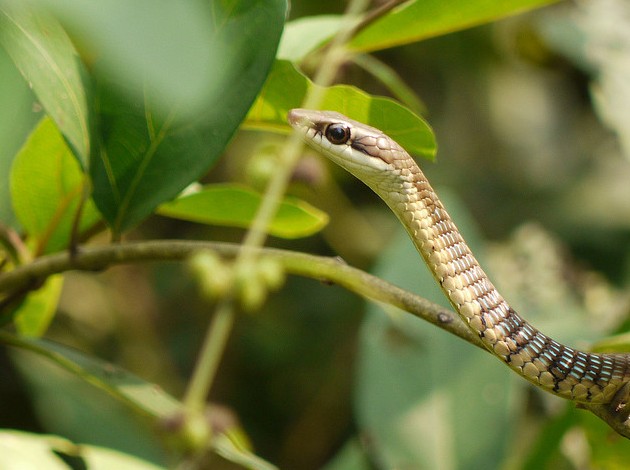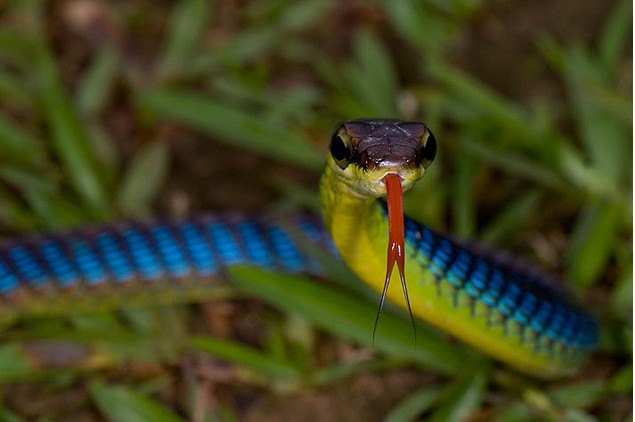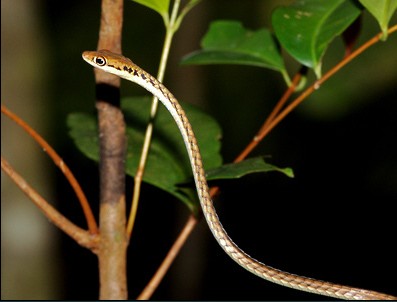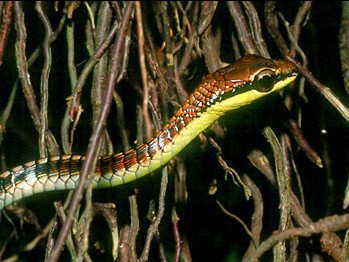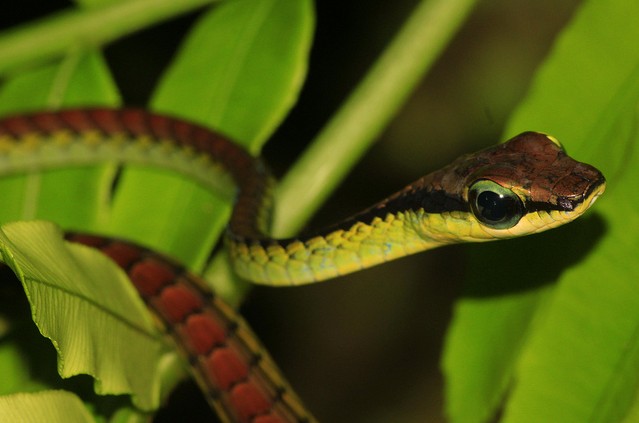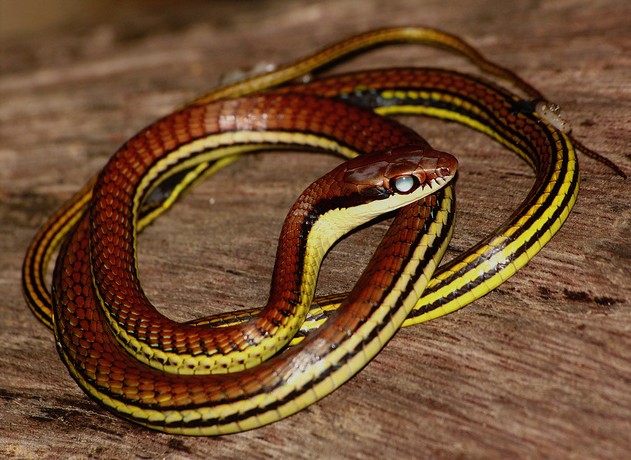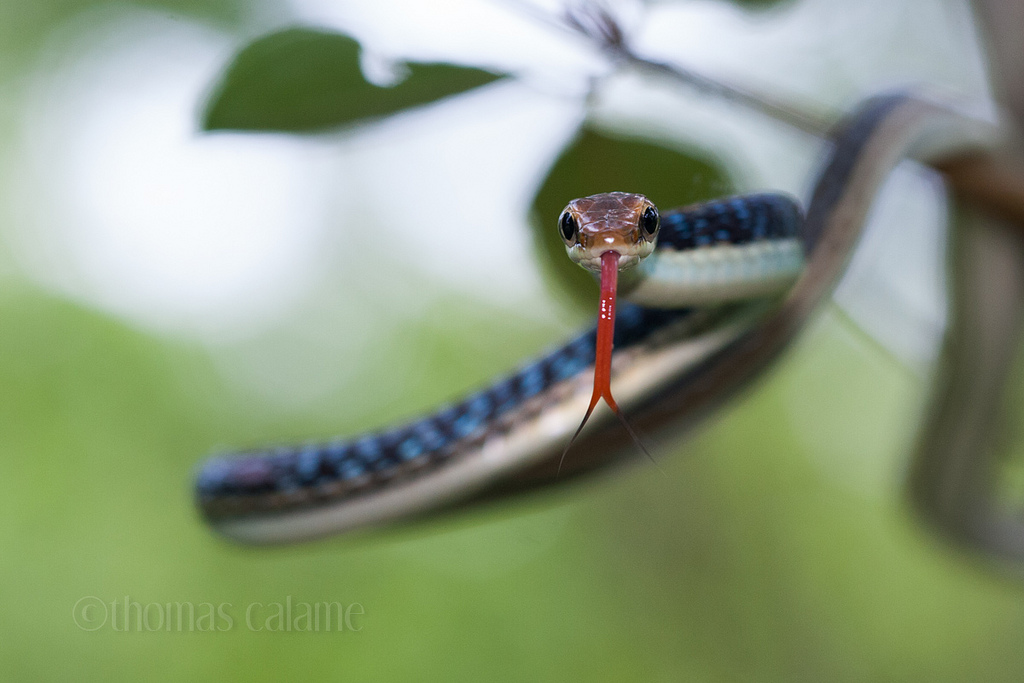
Table of Contents
| English name: Painted Bronzeback Scientific name: Dendrelaphis pictus Chinese name: 过树蛇 This non-venomous colubridea is one of the most commonly encountered snakes in Southeast Asia. It is present in ranging habitats such as cultivated areas, garden and parks, shrubs and forests (Lim and Lee, 1989; Stuebing and Inger, 1999; Chan-Ard et al., 2001). This small and slender snake is easily identified through its bronze dorsal colouration and a blunt snout. It has a diagnostic black eye-stripe beginning on the snout, passing through the eye and continuing down each flank. There is a cream lateral stripe beneath the black stripe along the length of the body. Its dorsal region has a cream or yellowish colouration (Ecology Asia). It can grow up to 120 cm with tail being one-third (Edward, 1874) |
|
Diagnosis
Characterization of Dendrelapis has been done by Rooijen and Vogel (2008) as well as Nicholson Edward (1874)
- 15 dorsal scale rows at midbody
- one loreal scale
- 6-7 temporal scales
- supralabials 4,5 and 6 touch the eye (4th with posterior corner)
- a short first sublabial that touches infralabials 6 and 7
- vertebral scales strongly enlarged, larger than the scales of the first dorsal row
- 183-189 ventrals
- 126-133 subcaudals
- a divided anal shield
- a relatively compact build, snout-vent length/ head-length 23.5-28.5
- a black postocular stipe that starts on the loreal, covers the whole temporal region and textends onto the neck where it is broken up oblique black bars
- the presence of black narrow stripe in the posterior half of body, covering the lower half of the third dorsal row
- the absence of a light ventrolateral stripe
|
|
 |
| Drawing of Dendrelaphis pictus Adapted from India Snakes, Nicholson Edward (1874) |
Biology
This diurnal species is predominantly arboreal. It can also be found on the edge of small clearings or in other habitat transitions for basking.
Prey and Being Preyed
It actively hunt on lizards and amphibians primarily (Rooijen and Vogel, 2008).
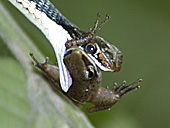
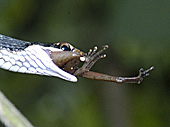
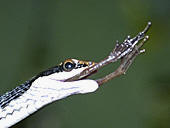
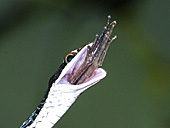
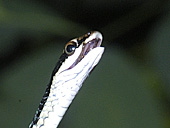
Dendrelaphis pictus preying on Copper-cheeked frog Rana chalconata (Photo by:Nick Baker @Ecology Asia)
Some cases of high "self-estimation":
A sub-adult Dendrelaphis pictushas been spotted in attempting to swallow a large tadpole prey in Singapore Zoo. The snake was resting on a waterlily (Victoria amazonica) with a tadpole which was identified as common greenback, Hylarana erythraea (Leong et al., 2009). The sub-adult was estimated to be 50 cm with a head width of 5-6 mm. The tadpole has noticeable skin tear and compression which matches the outline of snake's upper jaw.
 |
| A sub-adult painted bronzeback resting on waterlily with an abandoned tadpole (arrow) Photo by Charlene Yeong permission pending |
Picture on the left shows Dendrelaphis pictushas been spotted on habitat transition, grass patch of Nanyang Technology University, Singapore. The frog is likely to be a Field frog, Fejervarya limnocharis.
Due to its small body size, it also provide food for larger snakes and birds for prey.
|
|
Behaviour
| This active snake has restless habit and quick movement. It is usually shy and will flee quickly when disrupted. In time of threat, when it is cornered with no where to flee, it will inflate its body and flatten the neck laterally to reveal turquoish colour, wide gape and bright red tongue. |
|
||
| Dendrelaphis pictus is an inoffensive creature (Video taken in Thailand by: Vern L.) |
Dendrelaphis pictus found under mattress (Video taken in India by Faazea) |
Reproduction
Oviparous. Has been reported to lay 3-8 eggs in hollow tree stem.Period of gestation is believed to be 4 to 6 months and eggs hatch 4 to 6 weeks after laying. Development begins before they are voided (Daniel, 2002). Neonates hatch to be minature of adult snake are usually 8-12 cm long.
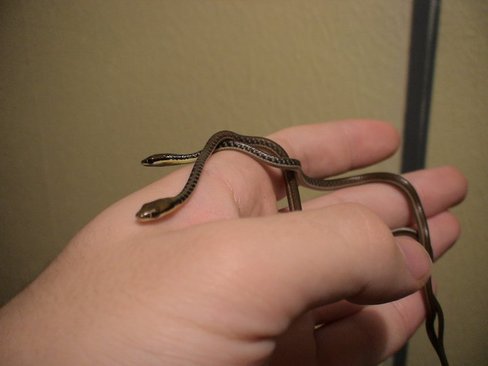
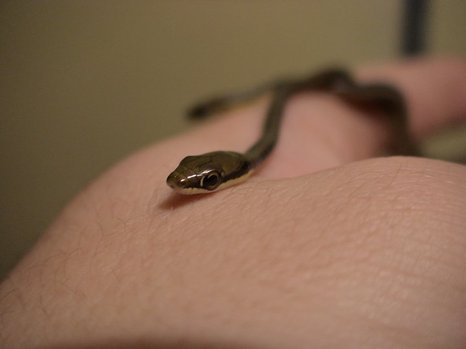
Neonates of Dendrelaphis pictus (Photo by: Francis Cosquieri, permission pending)
Distribution
Dendrelaphis pictus ranges from India, Myanmar, Southern China, Thailand, Peninsular of Malaysia, larger islands of Indonesia, Philippine Island and Singapore. It is widely observed in all habitats in Singapore and thus considered the most commonly encountered snake here.
View Untitled in a larger map
Sexual Diamorphism
Sexual dimorphism in morphology or body size is common among reptiles (Camilleri and Shine, 1990) . More than 60% of taxa of snakes are sexually dimorphic in adult body size with female larger than males (Shine, 1978).
In Dendrelaphis, females grow larger than males. Studies have done on head measurements and shown that females have relatively larger heads (Camilleri and Shine, 1990). This trait has been identified in many other species (Greene et al., 1997). Dietary divergence might be the important selective force for the evolution of head-size and shape dimorphism. Males have been reported to have larger eyes than females (Greene et al., 1997).
 |
| Head measurements done in Dendrelaphis (Camilleri and Shine, 1990) |
Close Relatives
Dendrelaphis has more than 40 de scripted species and some of them are closely alike.
| D. pictus Painted Bronzeback
|
|
||
| D. tristis Common Indian Bronzeback
|
|
||
| D. cyanochloris Blue Bronzeback
|
|
||
| D. haasi Haas' Bronzeback
|
|
||
| D. kopsteini Kopstein's Bronzeback
|
|
||
| D. formosus Elegant Bronzeback
|
|
||
| D. caudolineatus Striped Bronzeback
|
|
Taxonomy
Dendrelaphis pictus belongs to Colubridae which . There are three subspecies for this group: Dendrelaphis pictus pictus, Gmelin 1788 , D. p. inornatus, Boulenger 1897 and D.p. intermedius, Mertens 1927b (How et al., 1996)
The systematics of this genus have remained ambiguous and incomplete (Rooijen and Vogel, 2008). Many new species has been isolated for this group from different regions and their mophological descriptions has been updated along the way.
| Synonym |
Coluber pictus GMELIN in LINNAEUS 1789: 1116 Coluber ahaetulla LINNAEUS 1758 (part., nec Coluber pictus GMELIN 1789) Coluber boiga LACÉPÈDE 1789 (Name invalidated) Coluber pictus GMELIN 1789: 1116 Coluber decorus SHAW 1802: 538 Ahaetulla fasciata — LINK 1807 (fide STEJNEGER 1933) Ahaetulla decorus — GRAY 1825: 208 Dendrophis decorus — FITZINGER 1826: 60 Dendrophis pictus - BOIE 1827: 530 Ahaetulla bellii HARDWICKE & GRAY 1834 (fide ROOIJEN & VOGEL 2008) Dendrophis picta - SCHLEGEL 1837 Leptophis pictus - CANTOR 1847 Dendrophis picta — DUMÉRIL & BIBRON 1854: 197 Ahaetulla picta - COPE 1861 Dendrophis pictus var. - BOETTGER 1883 Dendrophis pictus — FISCHER 1884: 49 Dendrophis pictus — BOULENGER 1894: 78 Dendorophis (sic) pictus, forma typica - COHN 1905 Dendrophis pictus — WALL 1907: 189 Dendrophis proarchos WALL 1909 Dendrelaphis proarchos — WALL 1909 Dendrophis proarchus (sic) — WALL 1921:157 Dendrophis pictus — DE ROOIJ 1917: 58 Ahaetulla boiga - SCHMIDT 1927: 445 Ahaetulla boiga boiga — MERTENS 1930 Dendrophis pictus pictus - BRONGERSMA 1931 Dendrophis boiga - STEJNEGER 1933 Dendrelaphis pictus pictus - MERTENS 1934 Dendrophis pictus pictus — KOPSTEIN 1938 Ahaetulla boiga boiga - LADIGES 1939 Ahaetulla ahaetulla - SMITH 1943: 242 Ahaetulla picta picta - HAAS 1950 Dendrelaphis (boiga) -SAVAGE 1952 Dendrelaphis pictus - TWEEDIE 1983 Dendrelaphis pictus — MANTHEY & GROSSMANN 1997: 338 Dendrelaphis pictus — COX et al. 1998: 71 Dendrelaphis pictus pictus — GAULKE 1999 Dendrelaphis pictus — VOGEL & VAN ROOIJEN 2011 Dendrelaphis proarchos — VOGEL & VAN ROOIJEN 2011 |
Pet trade
This beautiful creature is very adaptable to wide range of habitat thus making it a popular subject for pet trade. Their abundance in Southeast Asia has also made them vulnerable to poachers. They can be easily found on online shops and many of the times they are sold out!!
Due to the unavailability of natural food resources, many of the keepers have to switch the diet of their snakes from frogs an lizards to rodent and worms. Snakes which do not prefer their new diet have to be force-feed which may be dangerous and easily cause injuries on snakes.
| Force feeding of a snake |
Green tree snake was feed using wax worm |
References
Caroline Camilleri and Richard Shine, 1990. Sexual dimorphism and dietary divergence: differences in trophic morphology between male and female snakes, Copeia 3: 649-658
T. Chan-ard, W. Grossmann, A. Gumprecht, K.-D. Schultz, 1999, Amphibians and Reptiles of Peninsular Malaysia and Thailand. An illustrated checklist, Wuerselen, Germany, Bushmaster publications
J. C. Daniel, 2002, The book of Indian Reptiles and Amphibians, Oxrford University Press
Nicholson Edward ,1874, Indian snakes: an elementary treatise on ophiology with a descriptive catalogue of the snakes found in India and the adjoining countries, Madras: Higginbotham
Harry W. Greene, Michael Fogden and Patricia Fogden,1997, Snakes: The Evolution of Mystery in Nature, University of California Press
R.A. How, L.H. Schmitt and Maharadatunkamsi, 1996, Geographical variation in the gnus Dendrelaphis (Serpentes: Colubridae) within the islands of south-eastern Indonesia, Journal of Zoology 238: 351-363
T.M. Leong, C. Yeong and R. Subaraj, 2009, Attempted predation on a tadpole by a Painted Bronzeback Dendrelaphis pictus (Reptilia: Squamata: Colubridae), Nature in Singapore 2:361-364
F.L.K. Lim and M.T.M. Lee, 1989, Fascinating snakes of Southeast Asia - An Introduction. Kuala Lumpur, Tropical Press.
R.B. Stuebing and R.F. Inger, 1999, A field Guide to the Snakes of Borneo. Kota Kinabalu, Natural History Publications
J. van Rooijen and G. Vogel, 2008. Contributions to a review of the Dendrelaphis puctus complex (Serpentes:Colubridae)-1. Description of a sympatric species, Amphibian-Reptilia 28:101-115
Richard Shine, 1978. Sexual size dimorphism and male comat in snakes. Oecologia 33:269-277
